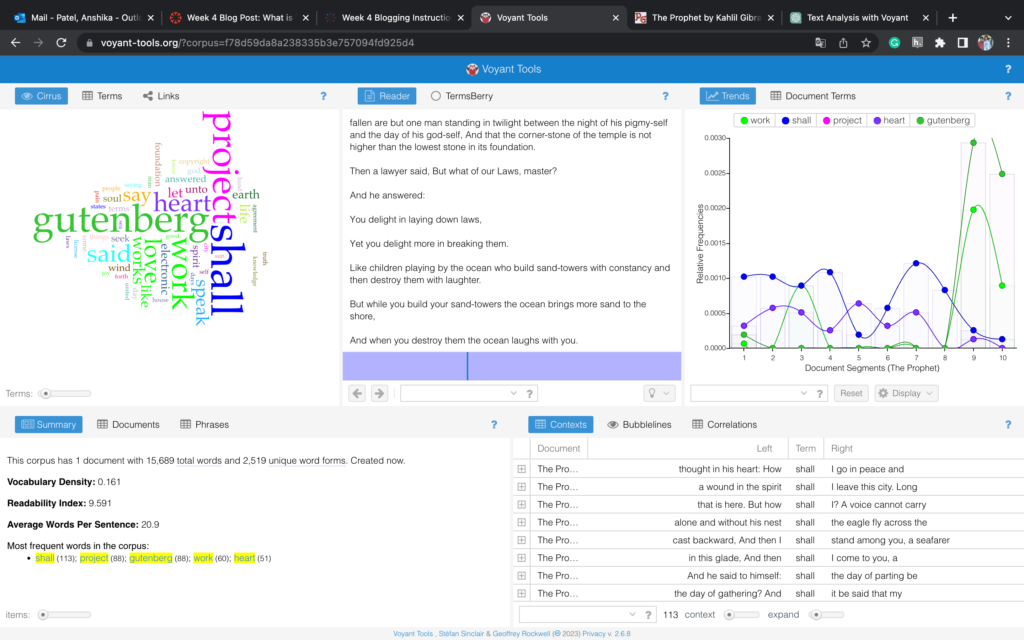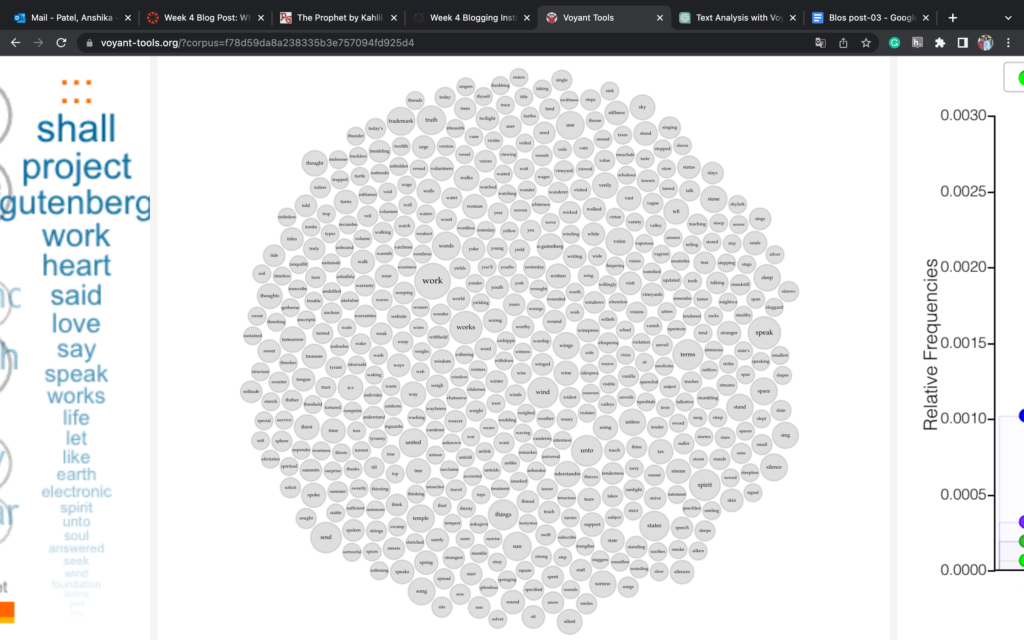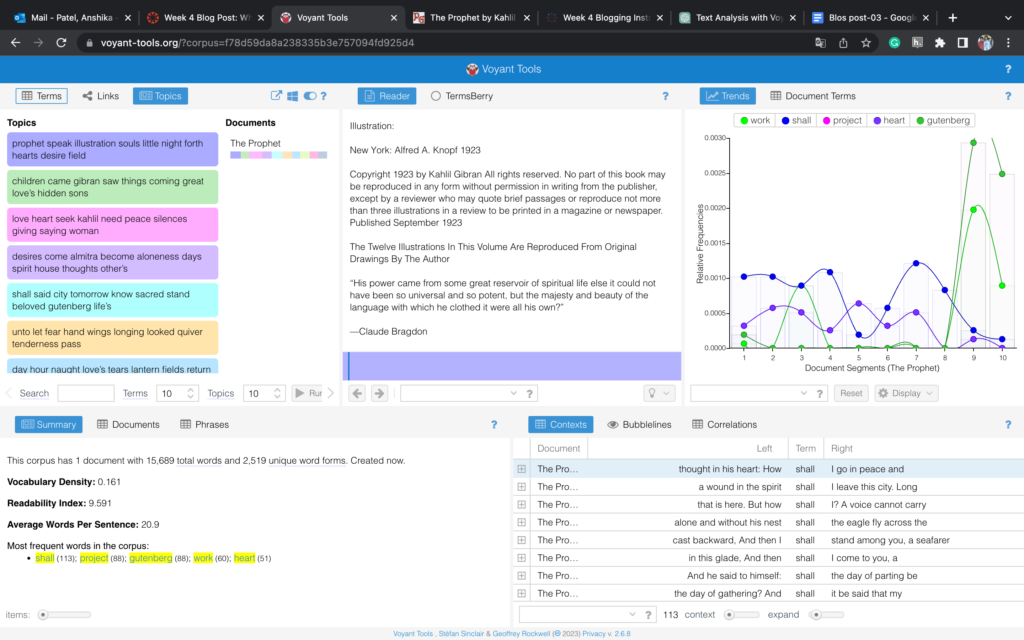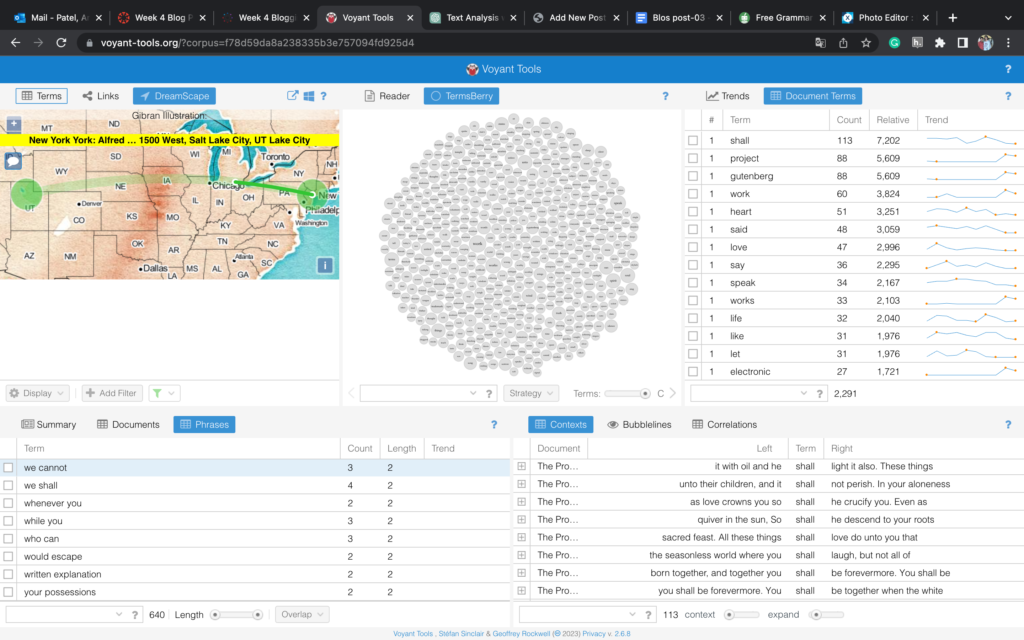Text analysis is when we look closely at written words using computers and special tools to find important information and understand what it means. We do things like counting how often certain words appear, figuring out the main topics, and even analyzing the emotions expressed in the text. It helps us learn more about the words and get valuable insights from them.

Most common words
Based on the most common words, in “The Prophet” by Kahlil Gibran, such as “shall, project, heart, Gutenberg, work,” the repeated use of “shall” suggests a contemplative or philosophical tone. It often implies a sense of duty, obligation, or future action. This indicates that the book explores themes related to personal growth, self-reflection, or the pursuit of a higher purpose. The terms “project” and “work” imply a focus on action, effort, or creative endeavors. These terms suggest that the book addresses the importance of meaningful work, self-expression, or the process of personal and spiritual development explained in “The Prophet” by Kahlil Gibran. Terms like “heart” suggest that the book delves into matters of emotion, passion, and the human experience. It could point to discussions about love, compassion, or the depth of feeling that shapes our lives. The presence of “Gutenberg” is intriguing as it refers to Johannes Gutenberg, the inventor of the printing press. It implies that the book incorporates elements of communication, dissemination of knowledge, or the power of written words to inspire and transform. It is worth noting that the presence of these words suggests that themes related to personal growth, meaningful work, emotional depth, and the power of written communication may be explored within “The Prophet.”

Least common words
Regarding the least common words from “The Prophet” by Kahlil Gibran, including “sign,” “solver,” “toss,” “void,” “wall,” “trap,” “soil,” “sorrowful,” and “softening,” the presence of the word “sign” suggests the inclusion of symbolism or allegory in the book. It implies that there are hidden meanings or deeper layers of interpretation to be explored. The uncommon word “solver” could imply a focus on problem-solving or the exploration of solutions to philosophical or existential questions. It suggests that the book engages with intellectual challenges or presents a thought-provoking perspective. The word “toss” indicates a sense of instability, uncertainty, or volatility within the book’s themes or characters. It implies a depiction of inner conflicts or external struggles. The term “void” suggests the exploration of emptiness, absence, or a sense of lack. It indicates themes related to existentialism or the search for meaning in the face of emptiness. Additionally, the presence of words like “wall” and “trap” indicates themes related to confinement, barriers, or obstacles. They could imply a focus on limitations, boundaries, or challenges to be overcome. The presence of these words indicates the exploration of a range of emotions, philosophical concepts, and existential themes in “The Prophet.”
To identify the topics, I used the document tool in Voyant. It provides multiple topics for the book.

Topics
One visualization tool called “Dreamscape” caught my attention, but I found it not very useful for my textual analysis. Its visualizations or results were difficult to interpret and didn’t provide meaningful insights.

Most Bizarre tool
The Textualarc tool, on the other hand, was quite perplexing and puzzling. It presented visualizations or results that were hard to interpret or didn’t offer valuable insights for my textual analysis. This tool had variations in its user interface, features, and effectiveness.

To export my results in Voyant Tools, I performed my analysis, and then I clicked on the “Share” button located at the top right corner of the screen. It appears as a square with an arrow pointing upward. A drop-down menu appeared with different export options. I selected the export format that suited my needs, such as Plain Text, HTML, JSON, or XML. By clicking on the desired export format, I downloaded my results to my device in the chosen format.
In conclusion, Voyant Tools helped me generate new questions by revealing patterns and relationships that may not be immediately apparent from reading the text alone. The tool’s visualizations and analytical features inspired new lines of inquiry and encouraged a deeper exploration of The Prophet” by Kahlil Gibran.
